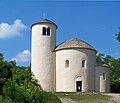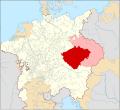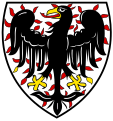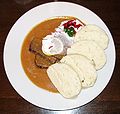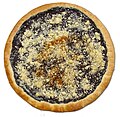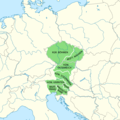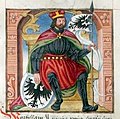Portal:Czech Republic
Welcome to the Czech Portal!
Vítejte na Českém portálu!

|

|
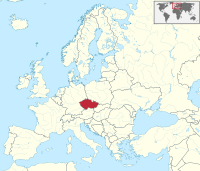
| |
The Czech Republic, also known as Czechia, is a landlocked country in Central Europe. Historically known as Bohemia, it is bordered by Austria to the south, Germany to the west, Poland to the northeast, and Slovakia to the southeast. The Czech Republic has a hilly landscape that covers an area of 78,871 square kilometers (30,452 sq mi) with a mostly temperate continental and oceanic climate. The capital and largest city is Prague; other major cities and urban areas include Brno, Ostrava, Plzeň and Liberec.
The Duchy of Bohemia was founded in the late 9th century under Great Moravia. It was formally recognized as an Imperial State of the Holy Roman Empire in 1002 and became a kingdom in 1198. Following the Battle of Mohács in 1526, all of the Crown lands of Bohemia were gradually integrated into the Habsburg monarchy. Nearly a hundred years later, the Protestant Bohemian Revolt led to the Thirty Years' War. After the Battle of White Mountain, the Habsburgs consolidated their rule. With the dissolution of the Holy Roman Empire in 1806, the Crown lands became part of the Austrian Empire.
In the 19th century, the Czech lands became more industrialized, and in 1918 most of it became part of the First Czechoslovak Republic following the collapse of Austria-Hungary after World War I. Czechoslovakia was the only country in Central and Eastern Europe to remain a parliamentary democracy during the entirety of the interwar period. After the Munich Agreement in 1938, Nazi Germany systematically took control over the Czech lands.
Czechoslovakia was restored in 1945 and three years later became an Eastern Bloc communist state following a coup d'état in 1948. Attempts to liberalize the government and economy were suppressed by a Soviet-led invasion of the country during the Prague Spring in 1968. In November 1989, the Velvet Revolution ended communist rule in the country and restored democracy. On 31 December 1992, Czechoslovakia was peacefully dissolved, with its constituent states becoming the independent states of the Czech Republic and Slovakia.
The Czech Republic is a unitary parliamentary republic and developed country with an advanced, high-income social market economy. It is a welfare state with a European social model, universal health care and free-tuition university education. It ranks 32nd in the Human Development Index. The Czech Republic is a member of the United Nations, NATO, the European Union, the OECD, the OSCE, the Council of Europe and the Visegrád Group. (Full article...)
Selected article -
The COVID-19 pandemic in the Czech Republic was a part of the worldwide pandemic of coronavirus disease 2019 (COVID-19) caused by severe acute respiratory syndrome coronavirus 2 (SARS-CoV-2). The first three confirmed cases in the Czech Republic were reported on 1 March 2020. On 12 March, the government declared a state of emergency, for the first time in the country's modern history for the area of the entire country. On 16 March, the country closed its borders, forbade the entry of foreigners without residence permits, and issued a nationwide curfew. While originally planned to be in effect until 24 March, the measures were later extended until 1 April and then again until the end of State of Emergency which was extended by the Chamber of Deputies until 30 April 2020 and then again until 17 May 2020.
Some measures undertaken by the Czech Republic differed in key aspects from other countries. A general curfew was in place between 16 March and 24 April, although with numerous exemptions. Apart from permitting essential shopping and going to and from work, as in other countries, it also permitted visiting relatives and allowed for unrestricted movement in parks and open countryside. A general closure of services and retail sales was in place from 14 March until 11 May; however, all shops could conduct socially distant sales with delivery through makeshift takeout windows and the gradual opening of selected shops started in several waves from 24 March onwards. Fear, anger, and hopelessness were the most frequent traumatic emotional responses in the general public during the first COVID-19 outbreak in the Czech Republic. The four most frequent categories of fear were determined: fear of the negative impact on household finances, fear of the negative impact on the household finances of significant others, fear of the unavailability of health care, and fear of an insufficient food supply. The government did not order the closure of manufacturing plants, but many did so voluntarily during the second half of March, with Hyundai spearheading a gradual reopening from 14 April. (Full article...)Selected picture

Photographer: Milan Nykodym, Czech Republic; License: Creative Commons CC-BY-SA
In this month
- 1 May 2004 – The Czech Republic joins the European Union
- 9 May 1974 – The Prague Metro begins operation
- 14 May 1855 – The book The Grandmother by Božena Němcová is released
- 27 May 1942 – An assassination attempt (pictured) on acting Reichsprotektor Reinhardt Heydrich in Prague as part of Operation Anthropoid results in him dying on 4 June – the villages of Lidice and Ležáky are razed to the ground in response
- 29 May 1975 – Gustáv Husák becomes President of Czechoslovakia, remaining in office until 1989
Categories
Selected biography -
Markéta Šimková (née Vondroušová; Czech: [ˈmarkɛːta ˈvondrou̯ʃovaː]; born 28 June 1999) is a Czech professional tennis player. She has a career-high singles ranking of world No. 6 by the WTA. Vondroušová is the reigning Wimbledon champion, winning the tournament in 2023, the first unseeded woman to win the singles title. She was also the runner-up at the 2019 French Open, where she became the first teenage Major finalist in nearly a decade. She has won two singles titles out of six finals on the WTA Tour and a silver medal at the 2020 Tokyo Olympics.
Vondroušová is a former junior world No. 1, having won two major doubles titles. She had a quick breakthrough on the WTA Tour, winning the 2017 Ladies Open Biel Bienne at age 17 in just her second career WTA Tour singles event. This helped her reach the top 100 of the WTA rankings before turning 18. Vondroušová struggled with injuries early in her career, most notably missing the second half of the 2019 season shortly after her French Open final. Her signature shot is the drop shot. She is one of the best returners on WTA Tour, having led the tour in percentage of return games won and percentage of return points won in 2019 among all players with at least ten matches. (Full article...)Did you know?

- ...that the Holy Trinity Column in Olomouc was inscribed on the World Heritage List as "one of the most exceptional examples of the apogee of Central European Baroque artistic expression"?
- ... that the report Public Finance Balance of Smoking in the Czech Republic found that the "effect of smoking on the public finance balance in the Czech Republic in 1999 was positive"?
- ... that Jan Maroši scored directly from a corner for Sigma Olomouc in a 1992–93 UEFA Cup match against Juventus?
- ... that Josef Jiří Kolár was the first to begin a systematic translation of Shakespeare's plays into Czech?
General images
Related portals
Topics

Czech lands: Bohemia • Moravia • Czech Silesia
History: Únětice culture • Boii • Marcomanni • Samo • Great Moravia • Přemyslid dynasty • Lands of the Bohemian Crown • Czech lands (1526–1648) • 1648–1867 • 1867–1918) • Czechoslovakia • Czech Republic
Geography: Lakes • Protected areas • Regions • Rivers
Law: Judiciary • Law enforcement • Supreme Court of the Czech Republic
Politics: Administrative divisions • Government • Constitution • Elections • Foreign relations • Army • Parliament • Political parties • President • Prime Minister
Economy: Banks • Czech koruna • Energy • Oil and gas deposits • Stock Exchange • Tourism • Transport
Culture: Architecture • Art • Cinema • Cuisine • Demographics • Education • Language • Literature • Media • Music • Philosophy • Prostitution • Public holidays • Religion • Sport • Television • Video games
Symbols: Flag • Coat of arms • National anthem (Kde domov můj)
Lists: Outline of the Czech Republic • List of Czech Republic–related topics
WikiProjects
Featured and good content
Things to do
Wikimedia
The following Wikimedia Foundation sister projects provide more on this subject:
-
Commons
Free media repository -
Wikibooks
Free textbooks and manuals -
Wikidata
Free knowledge base -
Wikinews
Free-content news -
Wikiquote
Collection of quotations -
Wikisource
Free-content library -
Wikiversity
Free learning tools -
Wikivoyage
Free travel guide -
Wiktionary
Dictionary and thesaurus






















